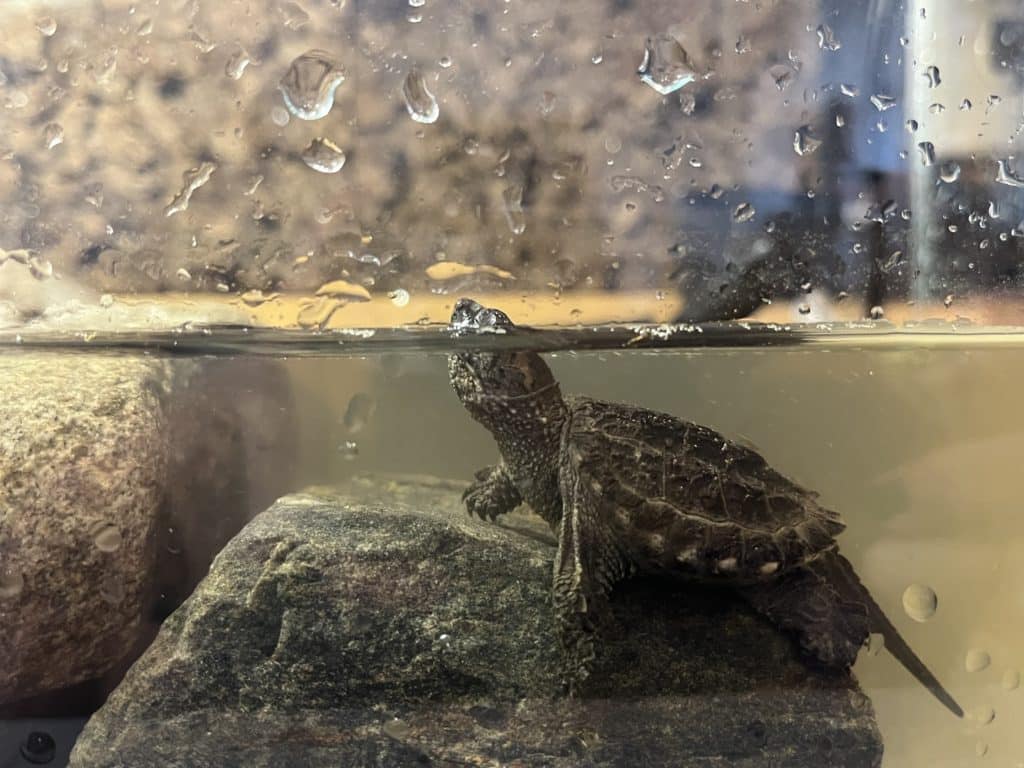
Earlier this fall, on September 7, some observant visitors notified our staff at Gilsland Farm that there was a baby Snapping Turtle in the parking lot. Echoing the events of three Septembers prior, we began searching the parking lot and surrounding area for tiny crawling turtles. Female Snapping Turtles secretively dig nests and lay eggs during the summer, and the eggs all hatch at the same time during the fall. We know that Snapping Turtles prefer to build nests in sand and gravel, and we eventually found a likely nest site in the gravel border around our Outdoor Classroom.
Over the course of that afternoon, at least a dozen hatchling Snapping Turtles were located in various locations, some a few hundred feet from the potential nest site. We carefully moved most of them to safer locations near the edge of the pond and the marshy areas along the Presumpscot River. One of the hatchlings, the biggest and muddiest, was chosen to overwinter in a tank in the Visitor Center Discovery Room, where it will be able to eat and grow while its siblings are spending the winter in underwater mud.
This turtle is currently in its cozy new winter home, with a warm UV light for basking, fresh pond water, and plenty of mealworms to chomp on. Come in and have a look whenever our Visitor Center is open (winter hours: 10 am to 4 pm daily). There’s also a box, next to the tank, where you can submit your questions about the turtle.
**NOTE: Please don’t try this at home! We are temporarily holding this turtle for educational purposes in consultation with our own biologists and with permission from the State of Maine. Snapping Turtles are not pets, and if you encounter turtles, babies or adults, please don’t interfere with their natural movements.**
Frequently Asked Questions:
How long can a Snapping Turtle stay underwater?
Usually, this Snapping Turtle will raise its head out of the water and take a breath every few minutes, but larger and older turtles can hold their breath for longer. During the winter, Snapping Turtles hibernate in the mud at the bottom of ponds. They do not breathe for up to six months while hibernating, only getting their oxygen from specialized cells in their mouth, throat, and cloaca. Sometimes, they are not able to get oxygen through any method, and are able to switch to anaerobic processes to stay alive without oxygen.
Why do turtles hide in their shells?
Snapping Turtles’ heads (and tails!) are actually too big to fit inside their shells, so they can’t hide in their shells. They evolved their powerful, snapping jaws to work as a defense mechanism to protect them from threats.
How old can they get? How old is this one?
We found this turtle as a hatchling on September 7, 2022, which means that it was likely a few days old. So now (as I write this on October 31), it’s not quite two months old. They reach maturity and are able to breed between 10 and 15 years old. Snapping Turtles can live for more than 100 years in the wild.
How small was it when it hatched?
This turtle weighed less than half an ounce (12 grams) on the first day we found it. That’s about the same as two quarters, or one empty soda can. It has gained almost 3 grams of weight already, and counting! Adult Snapping Turtles can weigh more than 20 pounds, with the largest individuals growing to more than 70 pounds.
What do they eat?
Snapping Turtles are omnivores, meaning that they eat many different things. This includes aquatic plants and invertebrates like you can see in the tank. When they get older and larger, they will eat fish, frogs, reptiles, birds, and mammals! They will pretty much eat anything that they can swallow.
